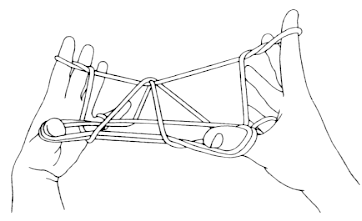Most string figures are formed and displayed on the hands. However, in some cases the finished pattern is released onto a flat surface and arranged. The Australian aborigines of Yirrkala were quite fond of this technique (see the many examples in our 1995 Bulletin).
Here is a string figure from Bolivia that resembles a footprint. It is most effective when placed on the ground. The method for making this simple figure was reconstructed by Ron Read of Canada.
When made using the recommended string length, the final figure resembles a human footprint. But when made with a shorter or doubled loop, the final figure resembles the paw print of a wild animal. Try making it both ways!

Protection from the elements is a basic human need. For centuries humans have preferred dwellings with pointed or cone-shaped roofs. A slanted roof prevents rain from accumulating, thus reducing the likelihood of leaks. Even temporary shelters like tents are conical or A-shaped.
Not surprisingly, dwellings of various types are represented in nearly every traditional string figure repertoire. Most often these figures are three-dimensional. The ‘House’ figure described here is prism-shaped, just like a traditional Papuan home. The figure is easy to form and holds its shape well, even when over-extended.

Traditionally the Chama of Peru lived on the banks of the Ucayali, a river that runs parallel to the Andes. Their preferred dwelling, which lacked walls to promote ventilation, consisted of a wooden framework with short corner posts. The structure was topped by a large thatched roof whose eaves nearly touched the ground.
Like the preceding ‘House’ figure from Papua New Guinea, this ‘House’ from Peru is three-dimensional and prism-shaped. Its method of manufacture is entirely different, but it likewise extends well and is easy to form.

This two-diamond action figure from Africa mimics breathing. When the forearms are twisted the diamonds expand and contract, just like a pair of lungs. This figure is followed by a second figure which represents a hunter’s spear. It’s not clear if the first figure represents the lungs of the hunter, who hides quietly in the bush awaiting his prey, or those of the wild animal he stalks.

The Pangwe (PAHNG-weh) were excellent blacksmiths. According to legend, they learned ironworking from 'the dwarfs' -- the pygmies who once lived in Pangwe territory. Pangwe blacksmiths enjoyed making jewelry, axe blades, knives, spades, and spearheads.
‘Spear’ is a continuation of ‘Breathing’. It is a realistic representation of a Pangwe hunter’s favorite weapon.

Like many islands in Micronesia, Nauru is a low coral atoll located near the equator. Although surrounded by a vast ocean, water is scarce: rain and shallow wells dug in the coral sand are the only sources of fresh water. Because of severe periodic droughts, fresh water wells are of great importance to the islanders. As a result, wells are viewed as symbols of beauty, fruitfulness, and wealth. When shown a new diamond string figure of great beauty, islanders will often remark that the diamonds represent wells.
In this string figure a single diamond represents the all-important well. The vertical bar next to it represents the well’s owner. This figure was selected because it closely resembles the preceding figure (‘Spear’), even though its method of manufacture is completely different!
